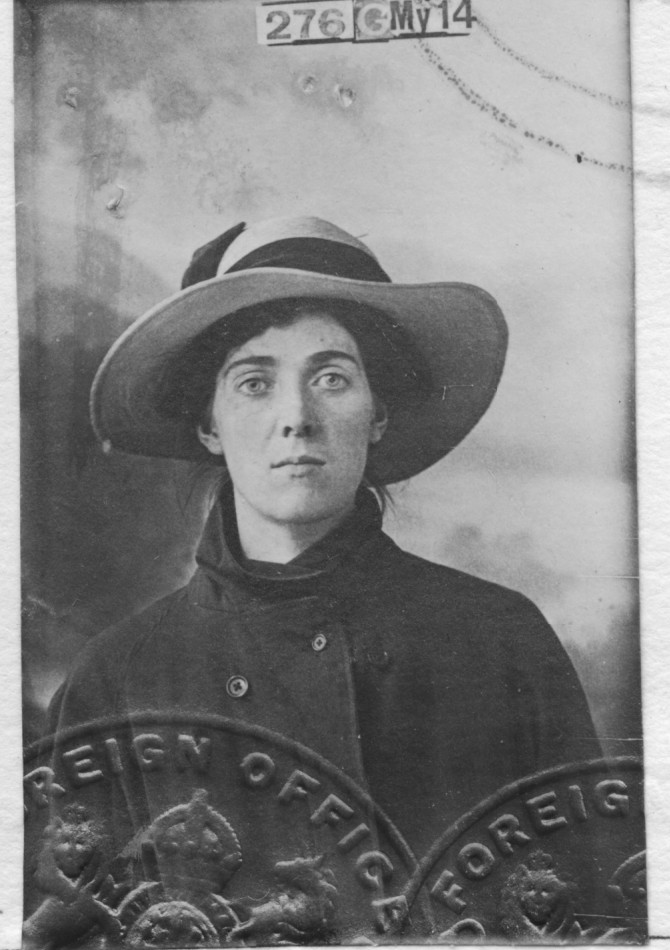
Miriam's 1918 passport picture.
| The Meigle Wightons |
| Generation 7: Miriam Eileen Wighton (Jackson) | |
 |
|
|
Miriam's 1918 passport picture. |
|
| Grandparents | John Baxter Wighton and Catherine Latta | Alexander Hutcheon & Margaret Strachan Burns | ||||
| Parents | John Murray Wighton | Amy Louisa Hutcheon | ? Jackson | unknown | ||
| Our Gen.7 Ancestors | Harry (Latta) (b. 1886) | wed (1912) | Miriam Eileen Jackson (b. 1890) | |||
| Miriam (Eileen)'s Siblings | Beatrice Alexandra (b.?) | Billy (b.?) | ||||
| Miriam (Eileen)'s Children | (Amy) Ella (b.1913) | John (Latta) (b.1915) | James (Jackson) (b.1916) | Doreen (b. 1918) | ||
|
|
|
|
Miriam in St Johnston |
|
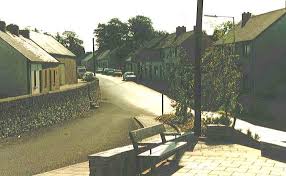 |
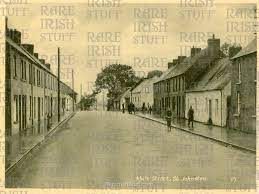 |
| Village of St. Johnston, circa early 1900's |
Village of St. Johnston, circa early 1900's |
|
Miriam was born October 23rd, 1890 in St Johnston (officially Saint Johnstown), which is in County Donegal, Northern Ireland. St. Johnston is a small village, which had a population of 583 in 2017. There wouldn't have much more in 1890. See photos above for two old postcard pictures. Miriam was baptized Mary Ellen Geraldine Bruce Jackson, which was quite a mouthful. No parents were listed on the Irish Gaelic certificate. That name didn't last. At some point, in response to some pressure from her aunts, the name was changed. As Miriam explained in a legal document she wrote late in life, her aunts argued that her sister Beatrice Alexandra had a fancy name. Miriam deserved one too. Keeping the same two initials (M, E) they called her Miriam Eileen. She still had the Geraldine Bruce names. At some point, Miriam herself chose to drop those two names and named herself Miriam Eileen Jackson. Here's another possible explanation for the name change. Miriam lived in the Irish province of Ulster, which at the time wanted to maintain ties with Britain. The rest of Ireland had a catholic, nationalist majority who wanted independence. You could say that tensions between the two were high. This first came to a head in 1892 when the UK introduced a bill to give Ireland home rule. Protestant unionists in Ireland opposed the bill fearing religious persecution of Protestants by a Catholic-dominated Irish government. In 1912, more than 500,000 Unionists pledged to oppose home rule by any means and to defy any Irish government. This is the political environment that Miriam lived in. (This was the beginning of a long 'war' that wasn't settled until 1988 with the signing of the Good Friday Agreement. What does this have to do with Miriam's name? Miriam was a devout Protestant. We know that she was vigorously opposed to the idea of the Catholic south ruling Northern Ireland because she banned all green clothes from entering the house. (Green = Eire's national colors.) So, we have a devout unionist named Mary, which is the name of a Catholic saint. That could be why she changed her name to Miriam Eileen. We don't know much about her schooling, other than she received an education to some level. She admitted to one of her grandchildren that she was top in her school. Miriam's mother died early for reasons we don't know. The father, a blacksmith, was a very controlling person by nature. As the oldest child, Miriam was expected to raise her sister Bee and her brother Billy. Her father was very demanding. Miriam was not a shy person. At some point, perhaps around 1908 when she was 18, Miriam left St. Johnston. As her cousins would explain to Dianne (Dianne Harding, Gen. 9) half a century later, she just up and disappeared. They didn't know where she had gone. |
|
|
Miriam emigrates |
|
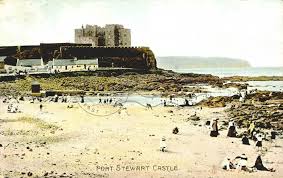 |
 |
| Portstewart, circa early 1900's |
Portstewart, circa early 1900's |
|
Portstewart (County Londonderry, on the northern tip of Northern Ireland) was a popular holiday destination for Victorian middle-class families. Its long, crescent-shaped seafront promenade was sheltered by rocky headlands. Just west of the town stretched Portstewart Strand, a clean two-mile long beach, protected by the National Trust. The Portstewart Strand had been popular with holiday-makers for generations. Saint Patrick's Well at the head of the strand, had been used in the 19th century and early 20th century for horse racing. You may be asking why Portstewart is on your screen. That's a good question. St Johnston is more than 40 miles away from Miriam's birth town, Portstewart. But that'a where Miriam was in 1910, if not earlier. She was in the town long enough for the minister of the town's Anglican Church to give her a character reference on June 18, 1910. Why would she want a character reference? Perhaps she was planning to move somewhere. A seaside resort that caters to the middle class would be attractive for a person who wished to work in Ireland's 'service industry.' We know that Miriam emigrated to Canada by taking a job as lady's companion, a.k.a. servant. Might she have met that lady there in Portstewart? However it happened, Miriam arrived in Quebec City On June 19, 1910 on the Lake Manitoba from Belfast with her destination Vancouver. Her papers indicated that she was a 'domestic' and planned to work as same on arival. The S.S. Lake Manitoba was part of the Canadian Pacific Railway and had room for 122 first class, 130 second class and 500 third class. (Source, cousin Margaret). |
|
|
The War Years |
|
|
As you have read in Harry's biography, he wanted to contribute to the war effort, so he, Miriam, Ella and John went to Scotland in August 1915. Harry ended up working in the munitions industry as a shell inspector. We have an envelope of various pieces of papers that Miriam had to use as she tried to buy food for her family during the war. These were: An army sugar permit allowing her to buy one ounce of sugar per head per day for a period of six days. #1: A 3" x 3.5" piece of paper with the title "Ministry of Food; Child's Meat Card" at the top. The left and right sides of the card had tear off pieces. The pieces were numbered as follows: 15, 15, 16, 16, 17, 17, 18, 18, 19, 19, and 20, 20. Some of these had been torn off. In the body of the meat card was the name of the issuing office (Glasgow), the name of the child (Amy E. Wighton), the address (11 Garnet Terrace), room for the Householder Signature (Harry L. Wighton), and the butcher's name and address. (This was done with a stamp: Robin's Butcher). On the back of the card, there were instructions on how to fill out the card. Also, the householder was told that each numbered coupon represented 1/4 of the child's weekly ration and could only be used in the week to which it related. Penalties for misuse could mean a 100 pound fine or six months imprisonment. #2: A meat ration card that applied to non-children, I assume. On the front was a place for the butcher's name and address. A stamp revealed that they patronized (J. Robinson, Butcher, Mount Florida. (This was the neighborhood where they were living). Also on the front was a grid of squares formed by eight columns and eight rows. The butcher would put a big X in the appropriate little box when meat was purchased. The columns were labelled: Saturday, Monday, Tuesday, and Thursday and then Saturday, Monday, Tuesday and Thursday again. (All butcher shops were closed on Wednesdays and Fridays. All shops of any kind were closed on Sundays.) A space at the bottom of the card had Harry's name and his address. The rules were on the back of the card and detailed that a household could only register with one butcher. Also, the amount of meat that could be sold was "the proportion of such allowance of meat as the Food Control Committee may fix for each person in the household as the Food Control Committee may fix for each week commencing Saturday." Meat included Beef, Mutton, Pork, Edible Offal, Sausages and Bones. (Offal means the edible organs of the animal; it is frequently spelled as Awful.) #3: A Retailer's Sugar Ticket which had not been filled in. The back of the card had spaces for Surname, Christian Name, Birthday, Address, Signature and date. Incidentally, the family also had a partially used Canadian ration book for WW II. It doesn't say what was being rationed. |
|
|
The Four Children | |
|
Ella was born October 7, 1913 in Vancouver. Her formal name was Amy Ella Wighton but she went by Ella. The Amy came from her grandmother on Harry's side, Amy Louisa Hutcheon. John Latta Wighton was born June 15, 1915 in Vancouver. The Latta name came from Catherine Latta, wife to John Baxter Wighton (Generation 5). Harry's middle name was Latta as well. I don't know if there was any particular reason for two appearances of the Latta name. James Jackson Wighton was born prematurely on December 31, 1916 in Glasgow Scotland. The Jackson name came from his mother's maiden name. The use of the mother's maiden name as a middle name for a child was common in Scotland. Doreen Wighton (b.?) died November 14, 1918 from the Spanish flu. The Spanish flu pandemic of 1918 infected an estimated 500 million people worldwide — about one-third of the planet’s population—and killed an estimated 20 million to 50 million victims. It lasted from February 1918 to April 1920 and had four successive waves. The 1918 flu was first observed in Europe, the United States and parts of Asia before swiftly spreading around the world. At the time, there were no effective drugs or vaccines to treat this killer flu strain. Citizens were ordered to wear masks. Schools, theaters and businesses were shuttered and bodies piled up in makeshift morgues before the virus ended its deadly global march. Back to preemie Jim Wighton. At the turn of the twentieth century, a baby born prematurely (before thirty-eight to forty weeks gestation) had dismal prospects for survival. Except for a few scattered pockets of medical interest, the knowledge, expertise, and technology necessary to help these infants was not available. “Preemies” who survived more than a day or two were often labeled “weaklings” or “congenitally debilitated” implying an inherent frailty that did not bode well for their future. Survival of these tiny infants depended on many factors, chief of which were the degree of prematurity and the infant’s weight at birth. The closed infant incubator was introduced by French physicians in the 1880s. In Europe, displays of premature infants in their incubators began appearing in the late nineteenth century at national fairs and exhibitions. These shows spread to the United States in the late 1890s and they continued until the 1940s. The small size of the infants, their placement in a machine similar to those used on farms for poultry incubation, and the encouragement of carnival style barkers stimulated the interest of the fair-going public. (I did not make this up.) While entertaining, the incubator exhibit’s identification as a side show and location among midway entertainment spectacles initially prevented mainstream physicians from embracing incubators as substantive progress. Their faulty design also posed serious problems. Over- or underheated incubators caused potentially fatal errors. Many physicians, relying on anecdotal rather than statistical evidence, dismissed the incubator as ineffective and even dangerous. Some hospitals provided care for preemies using other means of providing warmth, including open incubators and more traditional methods such as warm bricks in cradles and rooms heated to ninety degrees or more. (This information was found in "Care of Premature Infants as published in the University of Pennsylvania's Penn Nursing.) Miriam had her own way of caring for Jim. She wore him, as in she went everywhere with him pressed up against her inside her clothes. We don't know how prematurely he was born, but he turned out just dandy. As in Jim Dandy. |
|
|
Miriam's Family Re-visited | |
|
We know that Miriam had two siblings, Beatrice and Billy. We don't have dates on those births. We do know that, with Miriam's financial assistance, Beatrice emigrated to Canada and ended up living in South Vancouver, which was known as Marpole at the time. Beatrice (known in our family as Aunt Bea) married Mr. Thomas Bradbury who was a witness to Harry and Miriam's marriage. They had a son, Arthur. With Bea marrying Thomas Bradbury prior to Miriam's wedding, this suggests that the two sisters came over to Canada together. They also had a daughter, Eileen, who was born November 2,1918 in Vancouver. Miriam and Bea fought a lot because Bea wouldn't do what Miriam wanted. Miriam felt that she was entitled to boss her around because she had paid her way over from Ireland. Their last ever fight was about whether Bea and Miriam should help Billy come to Canada. This probably had been discussed several times previously. Possibly, Bea wanted Miriam to help pay for Billy's emigration. Miriam refused. Other harsh words probably were said. Miriam never talked to Bea after that. Bea died in 1955 without hearing from her sister again. In writing these biographies, I try to focus on the positives about my ancestors. Every one of them would have had personal failings of some nature. All of them had positives that were admirable. Miriam's inclination to angrily carry a grudge for a long time will appear again soon. It had a big impact on the Jim Wighton family. The rest of the family as well, but less so. This was part of who Miriam was. There were reasons for the difficulties that she had. I will explore those with you. In doing so, you'll come to know the real Miriam better, warts and all. Hiding her angry grudges would be dishonest. I've already mentioned that Miriam's father was a very controlling man, to the point where Miriam left everything and everybody behind her to find her freedom. There are ample psychological precedents to predict that the bad things about how a parent treats a child will often pass on to that child. In Miriam's case, they did. She became her father - a controlling person to her own children. The need to control, and her forever anger were a toxic combination. Back to Billy now. Billy sent Harry and Miriam a Christmas card probably in 1914 or 1915. He penned a few words about "the little children" and added that he was in India. The card was not the usual Christmas card. The inside of the card had these words printed on the left side: For the Past - Remembrance. For the Present - Best Wishes. For the Future - Good Fortune. Two military flags were printed on the right side of the card in colour. Each of these flags had the word Iniskilling inscribed in the centre of the flag. The front of the card had a small symbol with the same word. This was probably an all purpose military card. Some research was in order. The Royal Iniskilling Fusiliers was an Irish line infantry regiment of the British Army in existence from 1881 until 1968. The card was undated, but the history of the Fusiliers showed that they were in India in 1914 and 1915. Billy had joined the army and was serving in India with the First Battalion. It was landed at Cape Helles on the Gallipoli peninsula in April 1915. It was evacuated from Gallipoli to Egypt in January 1916 and then landed at Marseille in March 1916 for service on the Western Front. Billy survived the war, married, and settled in Australia. In the 1970's, he and his wife visited Canada and met with the Wightons. Perhaps the decision to not bring him to Canada wasn't a bad decision after all. But damage had been done and there was more to come. |
|
|
Emigrants to Canada | |
|
Canada is a nation that has relied on citizens of other countries choosing to emigrate here. Early in the nation's life, they were given inducements to emigrate. Cheap or free land, for one. There's a pattern to how immigrants integrate into the Canadian society. The parents often think of their homeland as their country. (Hence, Harry's desire to return to fight in the war.) They associate to a large extent with other adults from that country. They keep track of what's happening back home. If there's a language issue, they will often be reluctant to learn English or French. In such cases, their children will serve as translators. In terms of culture, they are steeped in the culture of their homeland. Their children, on the other hand, assimilate much more easily. The schools present a necessity for them to understand their new language. They associate with children their own age that come from a broader pool. In terms of culture, as in what parents are supposed to do and what children are supposed to do, they are living in the Canadian culture, (for better or worse); their parents may not have made that transition. Immigrants from the UK assimilate relatively easily. They look Canadian. They speak Canadian, albeit with a brogue or a lilt. But, the UK is steeped in traditions that go back many centuries. Canada, as a nation, did not exist before 1867. Britain has buildings that are older than our country. Most of those traditions evolved for a reason. The reason may not be vital any longer, but traditions do not change willingly. Take family size for an example. Peasants who lived on land that they could never own developed a tradition. 'Big families are good because the children can start working almost as infants.' The more workers there are on a rented piece of property, the more food they can grow. Granted, the size of families was influenced heavily by the lack of birth control. But for the parents, large families were critical. When the parents became too old to work, their children would take care of them. Their children were their retirement fund. In large families, some children would leave the nest, but not until they could support a wife and family. This often meant marriage in their late 20s. But not all of the adult children could leave. One or more of them had to stay to take care of Mom and Dad. There were no laws about this; but it was an expectation that was part of their culture. A big part! Families take care of each other. We took care of you. It's your turn now. Often that responsibility fell to the youngest to fulfill because (s)he was the last to leave. As the Wighton children grew older, they followed a tradition required by Miriam. Whatever you earn, that money goes into the family pot. Miriam handled the family pot and she did it well. They had survived the depression. They were saving up to put the two boys through university. All was well. But then, Ella left the nest to marry and work as a business secretary. She would not be putting her salary into the family pot, not with a child on the way. John took up a teaching job. He wasn't even in Vancouver and he would not be putting his salary into a family pot. That wasn't the Canadian way. Men got to keep the money they earned for themselves. Harry's income into retirement would be limited. Miriam did have part time work as a food displayer in a department store, but that was hardly enough to help them in their old age. This was the family's economic environment when Jim Wighton declared that he was going to marry and he'd be moving out. |
|
|
The Wedding | |
|
We don't know the specific pressure that Miriam used, but she made her feelings known. The marriage must not go forward. She wouldn't allow it. Bear in mind that Jim was 24 years old and a university graduate. Tradition said that the youngest took care of the parents. That meant, for Miriam, that he couldn't marry. However, the marriage plans proceeded. The betrothal was announced publicly. Invitations were sent out. The church was booked. Jim had had a choice to make: his new wife (Vera Bayley) or his mother. He chose Vera. As the marriage day of July 5, 1941 approached, the couple's thoughts kept returning to whether Miriam would attend. They didn't expect her to attend to help them to celebrate. They expected her to attend to stop the wedding from proceeding. The wedding ceremony of the time included this question: Should anyone present know of any reason that this couple should not be joined in holy matrimony, speak now or forever hold your peace. If Miriam were in the church, she'd be speaking. This would put the minister in a difficult position. Nobody ever responded to that question. The question was just a formality from a different era. There were no rules in the manual as to what the minister should do next if somebody didn't hold her peace. Should he say that he was proceeding regardless? He couldn't say that. Perhaps there was a legal reason for her objection. Perhaps they were cousins, for example. Should he direct the family to sort it out? That couldn't be done. Would the Wighton family that was present in the church as members of the wedding party escort her out? (Ella was a bridesmaid, her husband Otto was a groomsman, John was the best man.) How would they escort her out? Physical force? Reason would not work with Miriam. Bottom line: If Miriam came to the church, there would be no wedding. Let's take a little detour. The phrase “speak now or forever hold your peace” is rooted in Christianity and tradition. The sentence in question comes from the marriage liturgy section of the Book of Common Prayer. First published in 1549, the Book of Common Prayer provides guidelines for religious services, customs, and worship in the Church of England, or Anglican Church. Like the King James Bible, which was also published in England a few decades later, phrases from the Book of Common Prayer have worked their way into the canons of countries colonized or influenced by the British Empire. This particular question likely has less to do with God, and more to do with legal and practical concerns of the time. In the Medieval Age, it was very hard to get the word out that someone was getting married. So there was a tradition in most churches to announce upcoming marriages starting three consecutive Sundays before the wedding was to take place. Known as “banns," these proclamations read aloud by a priest were a formal announcement that a wedding was imminent. The last chance for objections would be on the wedding day. Why would someone go so far as to formally object to a union? It most often came down to law, not a last chance at true love. If someone knew a member of the couple to be already married, underage, unbaptized (church law), or forcefully coerced into the union, it was considered their duty to object. The same was true if they knew the couple to be too closely related by blood. Back we go to the Collingwood United Church, Saturday, July 5, and the ceremony has started. Jim and Vera are standing at the front of church, facing the minister. Both bride and groom are sneaking glances over their shoulder to see if Miriam had entered the church. Miriam hadn't, but that was because of Harry. The Wighton family had kept the date of the wedding and their inclusion in the ceremony from Miriam. On that Saturday, Harry distracted Miriam and kept her busy. I believe a movie might have been the distraction. At some point after the wedding, somebody informed her that they were married, but it was too late for her to stop it. I believe in Miriam's mind, she felt absolutely justified in her anger and opposition to the wedding. This emotion was not contrived. It was real and reasonable, in her mind. Jim had failed in his duty to the family. He had betrayed her. From this point on, Jim was out of her life. Vera took it personally. She thought that Miriam had opposed the wedding because she (Vera) wasn't good enough for her son. I doubt that was the case. I suspect that Miriam had very little personal contact with Vera during the courtship. If so, how could she form at opinion? I believe that it was her expectation that children take care of their parents that was uppermost in her mind. She wasn't going to be swayed by logic or reason. Add Miriam's habit of holding a grudge forever with her son's failed duty to care for his parents and you can see why the James Wighton family was out of her life forever. To review a bit. Miriam's sister, Aunt Bea, had two children. Art Bradbury did not have any children. Eileen Bradbury married a McTurk and they had a daughter Jean in the 1940's. There was a different side to Miriam that cousin Jean McTurk experienced. A tragedy in her family left Jean without parents when she was a teenager. Miriam offered her a room in the Wighton house, where she stayed for a while. Ella was also very supportive. |
|
|
Post Wedding |
|
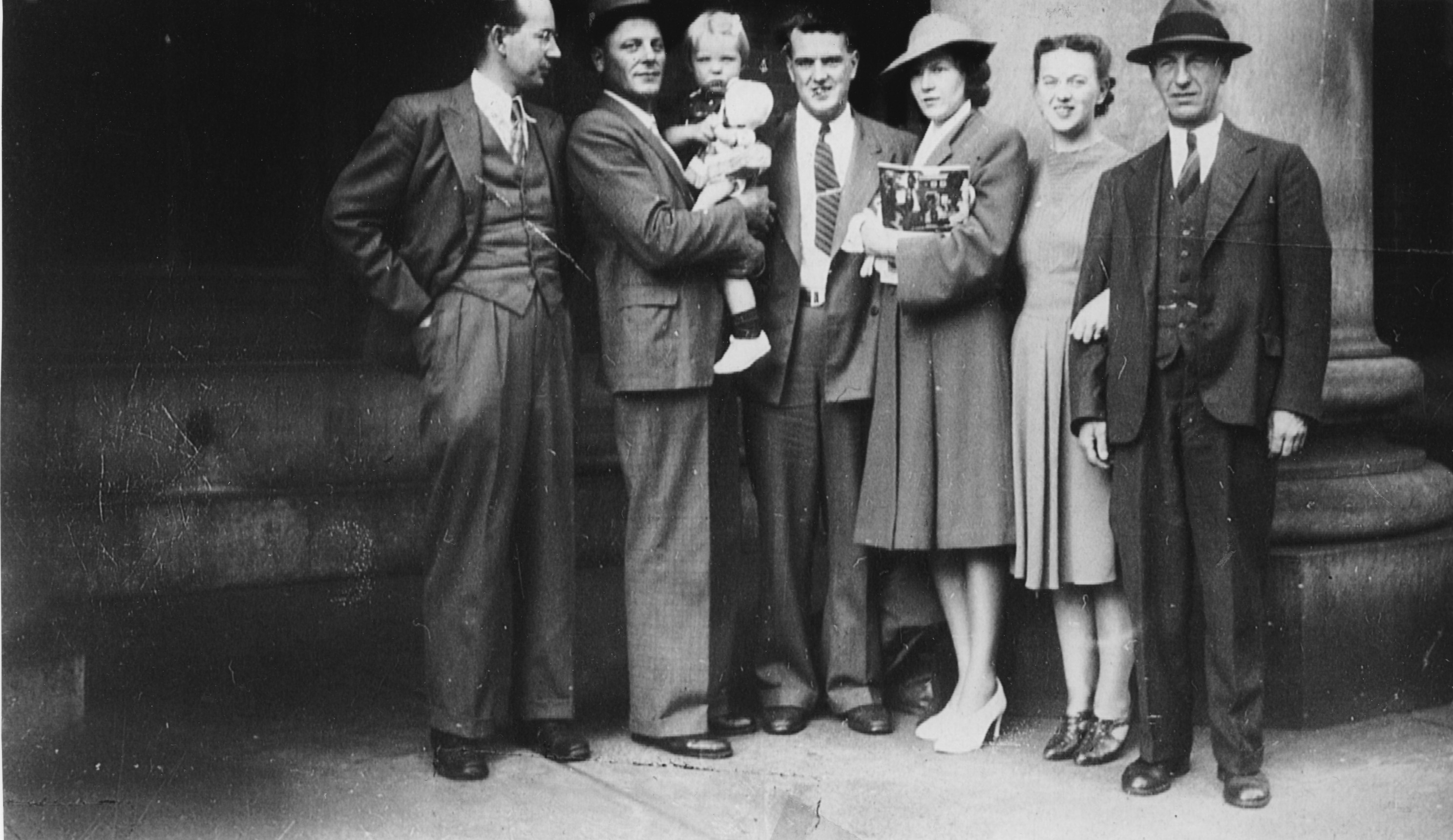 |
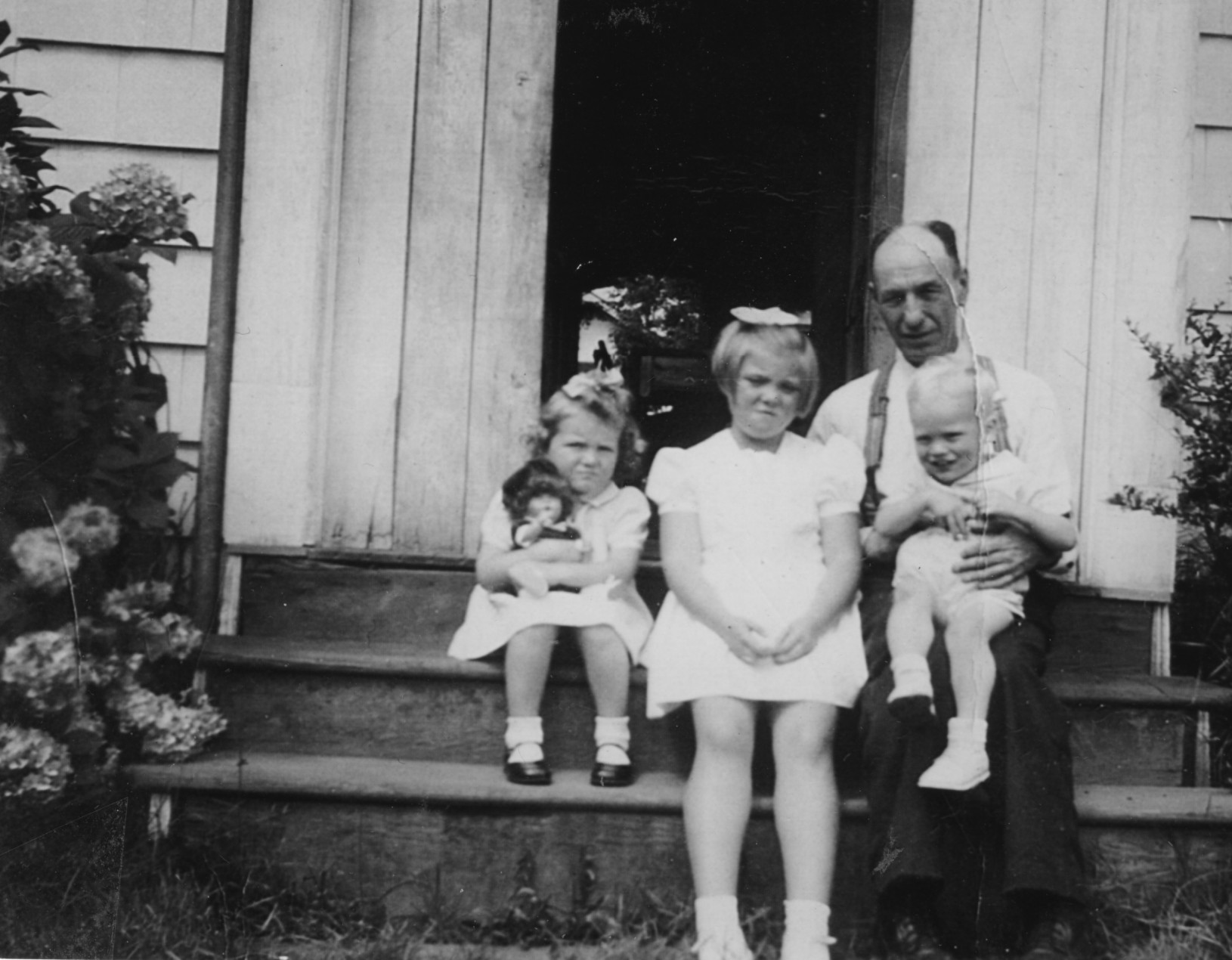 |
| John, Otto (Ella's husband), Marilyn (Ella's daughter), Vera, Ella, and Harry, Spring 1942 |
Left to right, Mary, Marilynne, David, and Harry in 1946 |
|
Before the wedding, Jim had volunteered for war service and had been provisionally accepted. In Spring 1942, he received orders to take up a position in Ottawa. (More about this is Jim's biography). The picture above left was taken as they were getting ready to leave for Ottawa. Vera was pregnant at the time.
After the war, Jim and Vera returned to Vancouver and took up residence on Lulu Island, south of Vancouver. The Wightons and the Petersons visited each other. Harry would travel to Lulu Island regularly for visits. See picture above right. Miriam was never there. One day in 1946, Vera was walking in downtown Vancouver. Vera's favorite son (the only son) was in a stroller. Miriam was walking too and they met on the sidewalk. Vera pointed out that the baby in the stroller was her grandson. Miriam kept walking without acknowledgement. In 1954, the Jim Wighton family moved to Montreal. In the thirteen years since the wedding, there had been no contact whatsoever from Miriam. |
|
|
Reconciliation |
|
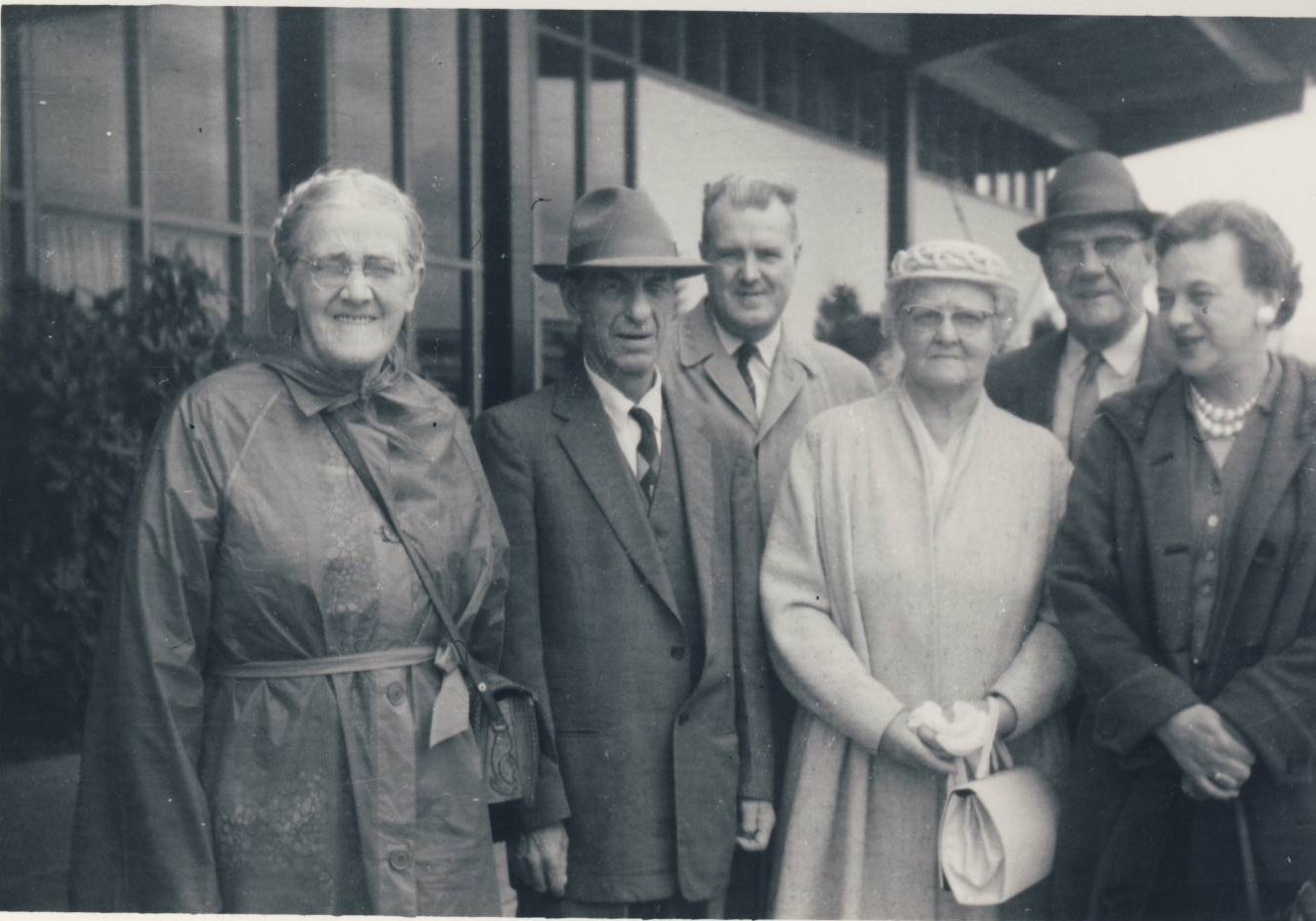 |
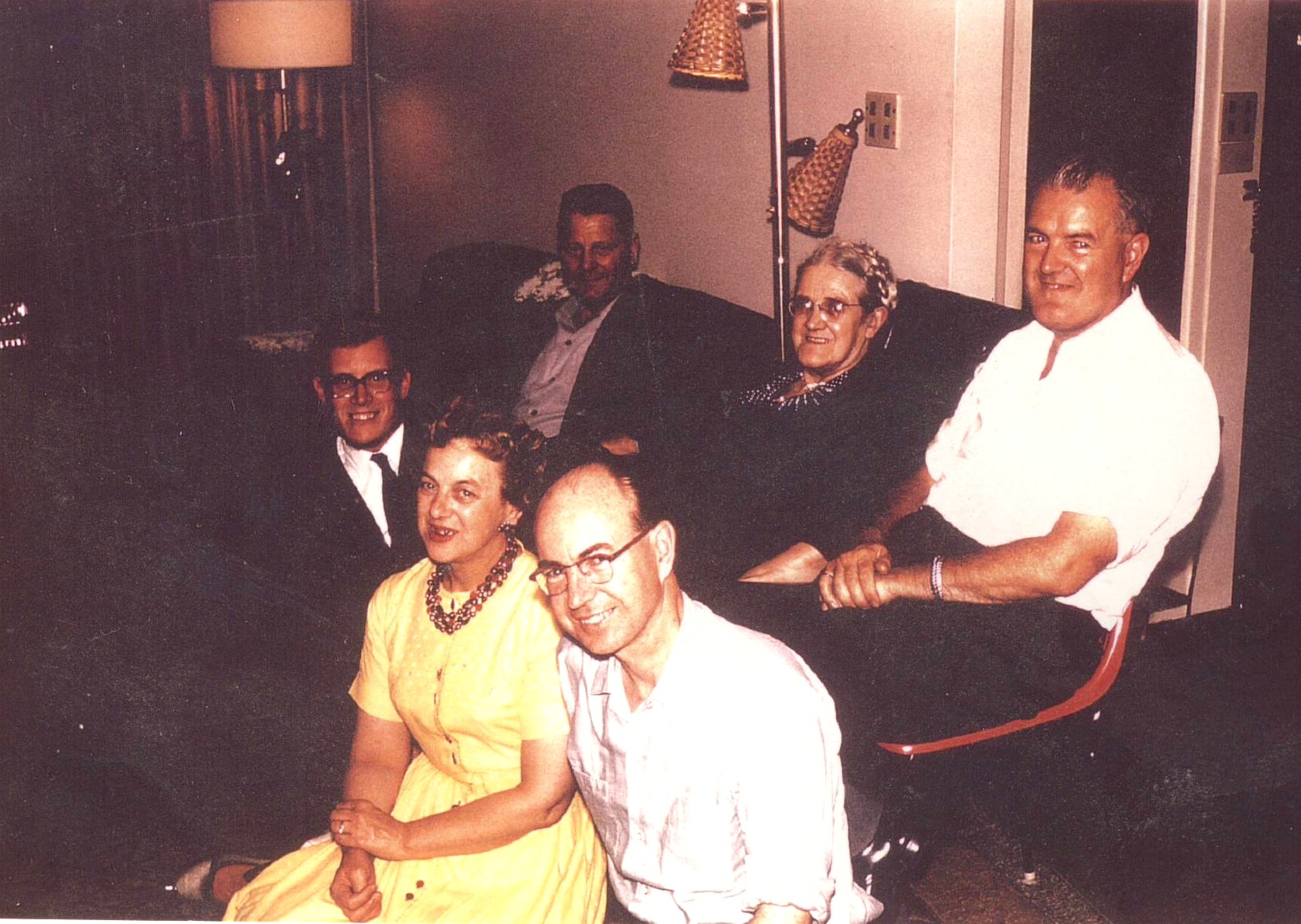 |
| Bayleys and Wightons celebrate 50th wedding anniversary | Wightons together in the 60s |
|
Some background information: With the Jim Wighton family in Montreal, Vera wanted to keep ties to her family (Susie and Wilfred Bayley) back in Vancouver. We would spend two (?) weeks in the summer living with the Bayleys. That was preceded and followed by a three day train trip. We got to see a lot of scenery which didn't get interesting until we were in Rockies. Otherwise, the three daily meals in the train's restaurant car were the highlight of the day. The highlight of the visit, for the kids at least, was the day we were allowed to go to the PNE (Pacific National Exhibit) by ourselves with Mary in charge. Back to Miriam's story. Miriam's sister, Bea, died in 1955. Miriam hadn't spoken to Bea for thirty five years at least. This prompted a thawing in her feelings about her son and his family. Communications between the two families began. Yes, the Wighton family would come to Vancouver and stay with Miriam and Harry for some time during the summer. I don't remember what year it was (1955?) when we added the Wightons to the summer holiday plans. I do remember that nothing had been said top us kids about who would be waiting for us at train station when we left Montreal. The first time I heard that I had a grandmother Wighton was on the train. None of the kids knew that we had two grandmothers before that trip. My reaction was: I have a grandmother Wighton? Huh. Is it time to eat yet? Our arrival had been carefully choreographed. We three kids would lead the way. The Wightons probably would be waiting for us just inside the train station. Grandma would be the one standing next to Grandpa Wighton. We had to rush up to her and give her hugs. Mom and Dad would follow behind. From our perspective, it worked. We now had two grandmothers. The biggest hit of living with Grandma and Grandpa Wighton, at least for me, was she gave us watermelon for breakfast every day and we could have a thick slice. Back home, watermelon was considered dessert and we didn't have it often. Also, I could have as much peanut butter as I wanted. (Alright, so I was of the age where I thought a lot about eating.) I'm sure that Mom and Dad had much more serious worries. But we survived. Later, Grandma and Grandma Wighton visited us in Montreal and we took them up to Quebec City for a day. They would carry on to Massachusetts where they would visit with Harry's sister, Amy, and her family. This was in 1957. The CBC promoted Dad back to Vancouver and he bought a house in North Vancouver. The picture above left was taken as part of a celebration for the 50th wedding anniversary of both couples who had wed on the same day and same year. Talk about a coincidence. From left to right, Miriam, Harry, Jim, Susie Bayley, Wilfred Bayley, and Ella. Harry died August 7, 1965. The whole family was together at the funeral. After Harry's death, Dad and Dianne visited Grandma from the north shore regularly. Dianne remembers going to Sunday night dinners with Dad when I was away at university. Before going home, Miriam would always press a Kraft caramel into her hand “for the ride home” and another one “for David”. Funny thing. I don't recall ever receiving my caramels. When I was home, I'd visit as well. The photo above right was likely one of those evenings. As to Miriam's concern that she'd die in penury eating awful offal, that didn't happen. John took a job at the University of British Columbia which was a 15 minute walk from Miriam' house. He moved back home and took care of her finances. As Miriam aged, she began to suffer badly from a weak back. She didn't trust doctors and refused to see one. Somebody in the family bought a chaise lounge and put it in the living room. Dianne recalls that she'd lay down on it for many hours at a time. She’d read the newspaper, but her eyes were so bad that she had to hold the paper right up to her eyes. The newsprint rubbed off on her nose. She’d also knit or crochet while flat on her back, which must have been extremely tiring and uncomfortable. Miriam knit two shawls from very fine wool as Christmas presents for Mary and Dianne. Miriam passed away on that chaise lounge on December 22, 1965 at the age of 75. |
|
|
Miriam's favourite joke An Irishman walks into a bar and asks for two beers. He then pulls a small green-skinned man out of his pocket and puts him on the counter. As he’s drinking one drink and the green man is drinking the other, an Englishman down the bar who has had a few too many drinks says, “Hey, what’s that little green guy doing down there?” The green man runs down the bar gives the Englishman a raspberry, “SPLBLBLBLT!,” right in the face and runs back to the Irishman. The Englishman mops himself off and says to the Irishman, “Hey, what is that thing, anyway?” The Irishman replies, “Have some respect. He’s a leprechaun.” “Oh, all right.” the Englishman says sullenly. They all go back to drinking beer. An hour or so later, the Englishman is really plastered. “Boy, that leprechaun sure is an ugly little bastard!” he says. The leprechaun runs down the bar and gives the Englishman a raspberry again, “SPLBLBLBLBT!” This time the Englishman is really mad! “Tell that leprechaun that if he does that again I’ll chop his willie right off, I will!” he shouts. “You can’t do that,” says the Irishman. “Leprechauns don’t have willies.” How do they pee, then?” asks the Englishman. “They don’t,” says the Irishman. “They go SPLBLBLBLBT.”
| |
|
I, Miriam Eileen Wighton, through the signature below, do certify that this is my favorite joke. | |
 |
|
|
Where to now? To read more about Generation 7, Harry Latta Wighton's immediate family, just click top to make a selection from Generation 7's genealogical table at the top of this page. The navigation buttons just below will give you quick access to biographies in other generations. |
|
| Home page Meigle Wightons | Generation #1 (John) | Generation #2 (William) | Generation #3 (Thomas) | Generation #4 (John) | Generation #5 (John Baxter) |
| Generation #6 (John Murray) | Generation #7: (Harry Latta) | Under construction: Gen#8 | Under construction: Gen#9 | Under construction: Gen#10 | Under construction: Gen#11 |
| Index of the members of the Meigle Wightons | Index of the Essays in the Meigle Wightons website | Return to the Wighton Family Genealogy home page | |||